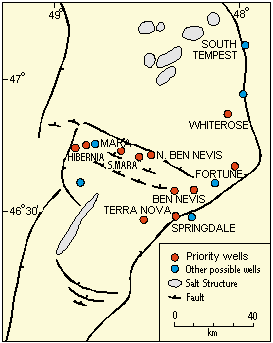Integrated Charge and Reservoir Evaluation
Ben Nevis Fault Zone Transect; East Coast Canada
RESULTS
Present and Past Distribution of Petroleum
Petroleum Type and Quality
Proximal Undrilled Pay
Bypassed Pay
Seals and Reservoir Compartments
Temperature and Timing of Petroleum Migration and Porosity Occlusion
Calibrated Model for Compaction & Quartz Cementation

11-18 Wells
3,000-5,000 Samples
(depending on level of participation)
TOOLS
Fluid Inclusion Stratigraphy
(volatile mapping)
Fluid Inclusion Petrography
Fluid Inclusion Microthermometry
API Gravity of Petroleum Inclusions
MCI
TM(Fluid Inclusion Biomarkers)
Direct Crush GC of Fluid Inclusions
Reservoir Quality Assessment
1D Basin Modeling
Diagenetic Modeling
Fluid Inclusion Technologies, Continental Labs, the University of Aberdeen and Geocosm
are conducting an evaluation of petroleum charge and reservoir quality in key wells from the Hibernia - Terra Nova area, East Coast Canada, to be offered as a non-exclusive study. The foundation for this study is fluid inclusion volatile analysis (Fluid Inclusion Stratigraphy or FIS) of 3,000-5,000 samples from 11-18 wells, representing an E-W transect in the vicinity of the Ben Nevis Fault Zone. This fault zone compartmentalizes distinctive oil types. Detailed fluid inclusion petrography, geochemistry and rock description will follow on potential reservoir sections that show significant FIS anomalies (possible migration pathways, paleo-hydrocarbon columns or present-day hydrocarbon columns). 1D basin modeling will be used to calibrate thermal histories for diagenetic modeling that will incorporate algorithms simulating the effects of compaction and quartz cementation on porosity and permeability. This model can ultimately be used to predict sandstone reservoir quality.Classical geochemical techniques that analyze residual pore fluids are often inadequate for determining where petroleum fluids have been, and are typically hampered by contamination, fractionation and alteration issues. Subsurface fluid processes leave resolvable chemical traces in the form of crystallographically
trapped fluids in diagenetic cements and healed microfractures. These fluid inclusions are not subject to evaporation during sample storage or loss of light ends during sampling from depth. They persist in the geologic record long after the parent fluids have moved on, but are continuously formed even up to the very recent past. Hence, fluid inclusion studies have the potential to provide a detailed account of petroleum distribution and charge history.Reservoir quality is often a key risk factor in exploring for deeply buried reservoirs. Generally, compaction and quartz cementation are identified as key reservoir destroyers in these environments. Recent studies have shown that empirically calibrated process models can effectively simulate the evolution of porosity through time, particularly when sandstone composition, texture and coating materials are taken into account. These models provide the basis for
reservoir quality prediction away from established control points.Delivery date:
December, 2000. Pricing: $25,000 USD before August 1; $30,000 thereafter (based on a minimum level of participation); project details subject to change.Sean Emel
Phone: (403) 250-5125
Fax: (403) 291-9556
Fluid Inclusion Technologies &
Continental Laboratories
"An Alliance for Innovation"
Email:
Web: www.fittulsa.com